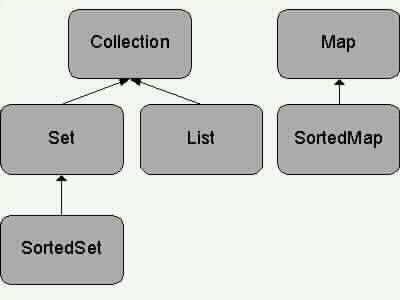| Collection |
-
A group of objects with no particular restrictions (e.g., a Bag)
-
Two constructors should be provided:
-
Void (no argument) constructor - create an empty Collection
-
Collection as argument - create a Collection containing
same elements as constructor argument
|
| Set |
-
Extends Collection, but adds no methods
-
No duplicates permitted - implied contract is that a constructor may not
create a set with duplicates
|
| SortedSet |
-
Extends Set
-
Elements sorted in some order - elements must implement Comparable,
or SortedSet must have a Comparator
associated with it
-
Iterator will traverse
elements in ascending order
-
Four constructors should be provided:
-
Void (no argument) constructor - create an empty SortedSet
-
Collection as argument
-
create a SortedSet containing same elements as constructor argument
-
ordering follows elements natural order
-
Comparator as argument
-
create an empty SortedSet
-
ordering is managed by Comparator
-
SortedSet as argument - create a SortedSet with same elements
as argument.
|
| List |
-
Extends Collection
-
Also known as a sequence
-
Ordered
-
Provides positional access/insertions
-
Position specified by integer
-
Duplicates permitted
-
Similar to JDK 1.1 Vector, but unsynchronized
-
ListIterator functionality
|
| Map |
-
Mapping of one key to one value:
-
No duplicate keys permitted
-
Each key can map to at most one value
-
Ordering determined by order of elements returned by Iterator
-
Provides 3 Collection views for interoperability
-
Similar to JDK 1.1 Hashtable, but unsynchronized
|
| SortedMap |
-
Extends Map
-
Elements sorted in some order (by key)
-
Iterator on any of the
3 views will traverse in ascending key order
-
Keys must implement Comparable,
or SortedMap must have a Comparator
associated with it
-
Four constructors should be provided:
-
Void (no argument) constructor - create an empty SortedMap
-
Collection as argument
-
create a SortedMap containing same elements as constructor argument
-
ordering follows elements natural order
-
Comparator as argument
-
create an empty SortedMap
-
ordering is managed by Comparator
-
SortedMap as argument - create a SortedMap with same elements
as argument.
|
